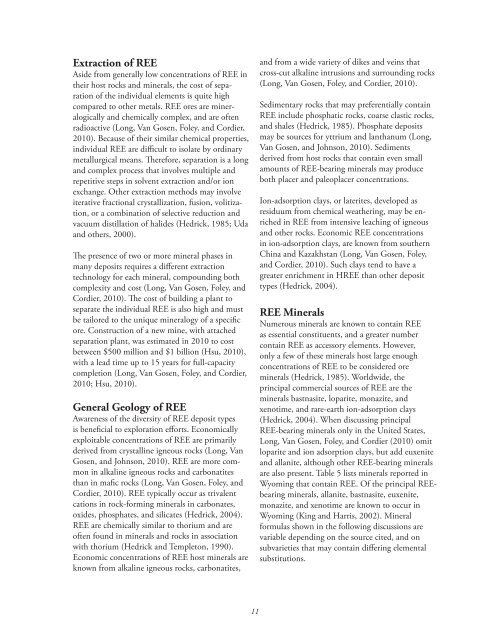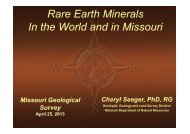Create successful ePaper yourself
Turn your PDF publications into a flip-book with our unique Google optimized e-Paper software.
Extraction of rEE<br />
Aside from generally low concentrations of REE <strong>in</strong><br />
their host rocks and m<strong>in</strong>erals, the cost of separation<br />
of the <strong>in</strong>dividual <strong>elements</strong> is quite high<br />
compared to other metals. REE ores are m<strong>in</strong>eralogically<br />
and chemically complex, and are often<br />
radioactive (Long, Van Gosen, Foley, and Cordier,<br />
2010). Because of their similar chemical properties,<br />
<strong>in</strong>dividual REE are difficult to isolate by ord<strong>in</strong>ary<br />
metallurgical means. Therefore, separation is a long<br />
and complex process that <strong>in</strong>volves multiple and<br />
repetitive steps <strong>in</strong> solvent extraction and/or ion<br />
exchange. Other extraction methods may <strong>in</strong>volve<br />
iterative fractional crystallization, fusion, volitization,<br />
or a comb<strong>in</strong>ation of selective reduction and<br />
vacuum distillation of halides (Hedrick, 1985; Uda<br />
and others, 2000).<br />
The presence of two or more m<strong>in</strong>eral phases <strong>in</strong><br />
many deposits requires a different extraction<br />
technology for each m<strong>in</strong>eral, compound<strong>in</strong>g both<br />
complexity and cost (Long, Van Gosen, Foley, and<br />
Cordier, 2010). The cost of build<strong>in</strong>g a plant to<br />
separate the <strong>in</strong>dividual REE is also high and must<br />
be tailored to the unique m<strong>in</strong>eralogy of a specific<br />
ore. Construction of a new m<strong>in</strong>e, with attached<br />
separation plant, was estimated <strong>in</strong> 2010 to cost<br />
between $500 million and $1 billion (Hsu, 2010),<br />
with a lead time up to 15 years for full-capacity<br />
completion (Long, Van Gosen, Foley, and Cordier,<br />
2010; Hsu, 2010).<br />
General Geology of rEE<br />
Awareness of the diversity of REE deposit types<br />
is beneficial to exploration efforts. Economically<br />
exploitable concentrations of REE are primarily<br />
derived from crystall<strong>in</strong>e igneous rocks (Long, Van<br />
Gosen, and Johnson, 2010). REE are more common<br />
<strong>in</strong> alkal<strong>in</strong>e igneous rocks and carbonatites<br />
than <strong>in</strong> mafic rocks (Long, Van Gosen, Foley, and<br />
Cordier, 2010). REE typically occur as trivalent<br />
cations <strong>in</strong> rock-form<strong>in</strong>g m<strong>in</strong>erals <strong>in</strong> carbonates,<br />
oxides, phosphates, and silicates (Hedrick, 2004).<br />
REE are chemically similar to thorium and are<br />
often found <strong>in</strong> m<strong>in</strong>erals and rocks <strong>in</strong> association<br />
with thorium (Hedrick and Templeton, 1990).<br />
Economic concentrations of REE host m<strong>in</strong>erals are<br />
known from alkal<strong>in</strong>e igneous rocks, carbonatites,<br />
11<br />
and from a wide variety of dikes and ve<strong>in</strong>s that<br />
cross-cut alkal<strong>in</strong>e <strong>in</strong>trusions and surround<strong>in</strong>g rocks<br />
(Long, Van Gosen, Foley, and Cordier, 2010).<br />
Sedimentary rocks that may preferentially conta<strong>in</strong><br />
REE <strong>in</strong>clude phosphatic rocks, coarse clastic rocks,<br />
and shales (Hedrick, 1985). Phosphate deposits<br />
may be sources for yttrium and lanthanum (Long,<br />
Van Gosen, and Johnson, 2010). Sediments<br />
derived from host rocks that conta<strong>in</strong> even small<br />
amounts of REE-bear<strong>in</strong>g m<strong>in</strong>erals may produce<br />
both placer and paleoplacer concentrations.<br />
Ion-adsorption clays, or laterites, developed as<br />
residuum from chemical weather<strong>in</strong>g, may be enriched<br />
<strong>in</strong> REE from <strong>in</strong>tensive leach<strong>in</strong>g of igneous<br />
and other rocks. Economic REE concentrations<br />
<strong>in</strong> ion-adsorption clays, are known from southern<br />
Ch<strong>in</strong>a and Kazakhstan (Long, Van Gosen, Foley,<br />
and Cordier, 2010). Such clays tend to have a<br />
greater enrichment <strong>in</strong> HREE than other deposit<br />
types (Hedrick, 2004).<br />
rEE M<strong>in</strong>erals<br />
Numerous m<strong>in</strong>erals are known to conta<strong>in</strong> REE<br />
as essential constituents, and a greater number<br />
conta<strong>in</strong> REE as accessory <strong>elements</strong>. However,<br />
only a few of these m<strong>in</strong>erals host large enough<br />
concentrations of REE to be considered ore<br />
m<strong>in</strong>erals (Hedrick, 1985). Worldwide, the<br />
pr<strong>in</strong>cipal commercial sources of REE are the<br />
m<strong>in</strong>erals bastnasite, loparite, monazite, and<br />
xenotime, and <strong>rare</strong>-<strong>earth</strong> ion-adsorption clays<br />
(Hedrick, 2004). When discuss<strong>in</strong>g pr<strong>in</strong>cipal<br />
REE-bear<strong>in</strong>g m<strong>in</strong>erals only <strong>in</strong> the United States,<br />
Long, Van Gosen, Foley, and Cordier (2010) omit<br />
loparite and ion adsorption clays, but add euxenite<br />
and allanite, although other REE-bear<strong>in</strong>g m<strong>in</strong>erals<br />
are also present. Table 5 lists m<strong>in</strong>erals reported <strong>in</strong><br />
Wyom<strong>in</strong>g that conta<strong>in</strong> REE. Of the pr<strong>in</strong>cipal REEbear<strong>in</strong>g<br />
m<strong>in</strong>erals, allanite, bastnasite, euxenite,<br />
monazite, and xenotime are known to occur <strong>in</strong><br />
Wyom<strong>in</strong>g (K<strong>in</strong>g and Harris, 2002). M<strong>in</strong>eral<br />
formulas shown <strong>in</strong> the follow<strong>in</strong>g discussions are<br />
variable depend<strong>in</strong>g on the source cited, and on<br />
subvarieties that may conta<strong>in</strong> differ<strong>in</strong>g elemental<br />
substitutions.



